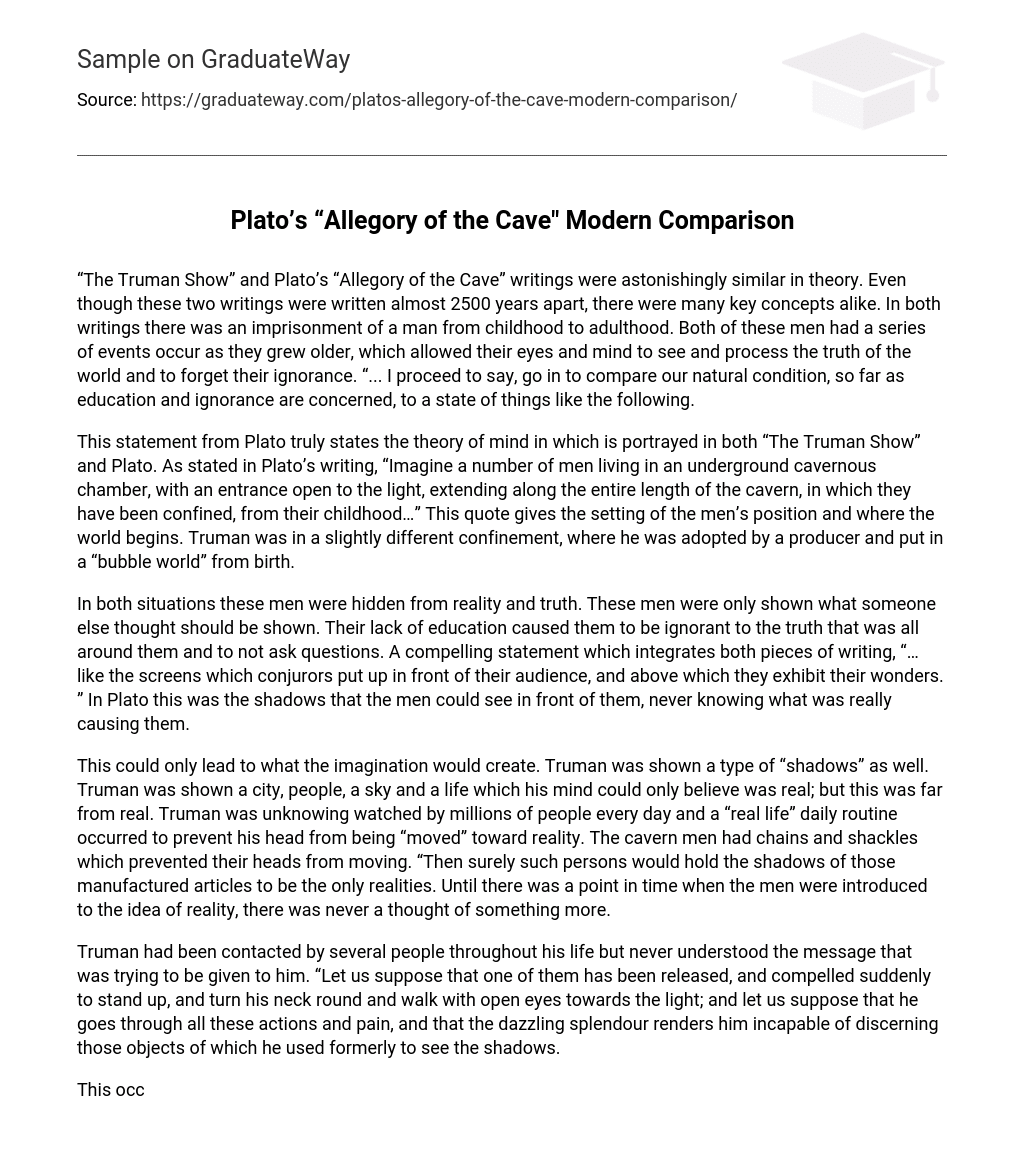“The Truman Show” and Plato’s “Allegory of the Cave” share astonishingly similar theories. Despite being written almost 2500 years apart, these writings exhibit many common concepts. Both stories revolve around the imprisonment of a man from childhood to adulthood. As these individuals age, they experience a series of events that enable them to see and comprehend the truth about the world and shed their ignorance. “… I proceed to say, go in to compare our natural condition, so far as education and ignorance are concerned, to a state of things like the following.”
In both “The Truman Show” and Plato, the theory of mind is depicted. According to Plato, “Imagine a number of men living in an underground cavernous chamber, with an entrance open to the light, extending along the entire length of the cavern, in which they have been confined, from their childhood…” This quote establishes the setting and starting point for the men. Truman, on the other hand, was raised in a similar captivity, adopted by a producer and placed in a “bubble world” since birth.
The men in both situations were concealed from reality and truth. They were only exposed to what others believed should be shown to them. Their lack of education rendered them ignorant of the truth that surrounded them, and they refrained from asking questions. A compelling statement that combines both writings is, “… like the screens which conjurors put up in front of their audience, and above which they exhibit their wonders.” In Plato’s work, these screens were represented by the shadows that the men saw in front of them without ever knowing their true source.
Truman’s perception within the constructed world he inhabited was meticulously crafted, including the city, people, and sky that appeared authentic to his mind. In reality, though, this presentation was far from genuine. Unbeknownst to Truman, he lived under constant surveillance by countless viewers while adhering to a scripted routine designed to keep him oblivious to the truth. Much like cave dwellers bound by chains, Truman’s understanding of reality remained confined to artificially created shadows. Only when the notion of actuality entered their consciousness did they start pondering their own existence.
Truman had been contacted by multiple individuals in his lifetime, yet he never comprehended the intended message. “Let’s imagine that one of them is set free and forced to abruptly rise, rotate his neck, and walk towards the light with eyes wide open. Furthermore, let’s assume he goes through all these motions and endures the associated pain. However, the overwhelming brilliance prevents him from distinguishing the actual objects that he previously perceived as mere shadows.
Truman experienced this on several occasions and became increasingly interested in uncovering the truth. He faced numerous cover-ups and moments of pain and perseverance. Similar to early humans, Truman was guided in the right direction but faced many obstacles on his journey. However, once he arrived, his thoughts on reality and possibility prompted him to choose the real world over the fabricated one. In Plato’s words, “Lastly, I imagine he will be able to observe and contemplate the nature of the sun, not as it appears in water or on foreign soil, but as it truly is in its own domain.” Truman was now liberated to explore, learn, and comprehend the true essence of living and understanding what is “good.” “The Truman Show” ultimately served as a commentary on modern society. Nowadays, trust is scarce, relationships can be one-sided, and real life often brings pain. By creating an alternate universe, director Peter Weir aimed to construct an ideal world.
Perhaps the director envisions a society free from war, hunger, disaster, hate, violence, and poverty. Unfortunately, today’s society is plagued by these issues and we have no solution to them. In Ancient Athens, people unquestioningly accepted various beliefs and ideas. Similarly, in our world today, although we believe we question ideas and rules, we still adhere to numerous theories, regulations, and norms every day. Henceforth, our modern society bears resemblance to the people of Ancient Athens.





